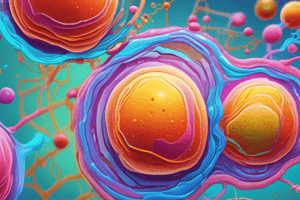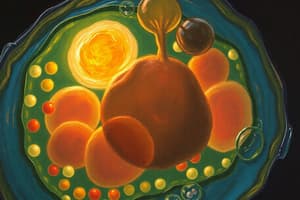Podcast
Questions and Answers
Which of the following structures is responsible for modifying and packaging proteins?
Which of the following structures is responsible for modifying and packaging proteins?
- Mitochondria
- Golgi apparatus (correct)
- Rough endoplasmic reticulum
- Nucleus
Which of the following is NOT a function of microtubules?
Which of the following is NOT a function of microtubules?
- Transporting organelles within the cell
- Forming spindle fibers during cell division
- Moving the cell (flagella)
- Synthesizing proteins (correct)
Which of the following structures is found only in eukaryotic cells?
Which of the following structures is found only in eukaryotic cells?
- Golgi apparatus (correct)
- DNA
- Ribosomes
- Cell membrane
What is the main function of the cell wall in plant cells?
What is the main function of the cell wall in plant cells?
Which of the following statements correctly describes the relationship between the rough endoplasmic reticulum and ribosomes?
Which of the following statements correctly describes the relationship between the rough endoplasmic reticulum and ribosomes?
Which of the following is NOT a difference between eukaryotic and prokaryotic cells?
Which of the following is NOT a difference between eukaryotic and prokaryotic cells?
Which of the following organelles is responsible for the production of ATP?
Which of the following organelles is responsible for the production of ATP?
What is the primary function of cilia?
What is the primary function of cilia?
Which of the following is the correct sequence of events in protein synthesis?
Which of the following is the correct sequence of events in protein synthesis?
What is the function of the nuclear membrane?
What is the function of the nuclear membrane?
Flashcards
Nucleus
Nucleus
Large organelle that contains chromosomes made of genes.
Nucleolus
Nucleolus
Dark spot within the nucleus that produces ribosomes.
Rough Endoplasmic Reticulum
Rough Endoplasmic Reticulum
Network of sacs with ribosomes, responsible for protein synthesis.
Smooth Endoplasmic Reticulum
Smooth Endoplasmic Reticulum
Signup and view all the flashcards
Ribosomes
Ribosomes
Signup and view all the flashcards
Golgi Apparatus
Golgi Apparatus
Signup and view all the flashcards
Mitochondria
Mitochondria
Signup and view all the flashcards
Chloroplasts
Chloroplasts
Signup and view all the flashcards
Cell Wall
Cell Wall
Signup and view all the flashcards
Eukaryotes vs Prokaryotes
Eukaryotes vs Prokaryotes
Signup and view all the flashcards
Study Notes
Nucleus Appearance
- Large organelle located in the center of the cell
- Stains darkly with DNA stains
Nucleus Function
- Contains chromosomes which are made up of genes
- Genes contain instructions to make proteins
Nucleolus Appearance
- Dark spots within the nucleus
Nucleolus Function
- Site of ribosome production
Nuclear Membrane/Envelope Appearance
- Membrane that surrounds the nucleus
### Nuclear Membrane/Envelope Function
- Separates the nucleus from the cytoplasm
- Protects DNA
- Contains pores that allow molecules to pass in and out of the nucleus
Rough Endoplasmic Reticulum Appearance
- Interconnected network of flattened sacs
- Ribosomes attached to the surface of the membrane
### Rough Endoplasmic Reticulum Function
- Protein synthesis
Smooth Endoplasmic Reticulum Appearance
- Interconnected network of membranes, not flattened sacs
- No ribosomes attached
Smooth Endoplasmic Reticulum Function
- Lipid and carbohydrate synthesis
Ribosomes Appearance
- Contains ribosomal (rRNA) and protein
- Hamburger-like structure
Ribosomes Function
- Protein synthesis using mRNA as an instruction
- Forms a complete ribosome from a small and large subunit
Transport Vehicles/Vesicles Appearance
- Membrane components
### Transport Vehicles/Vesicles Function
- Transport molecules from one organelle to another or to the cell membrane
- Types:
- Transport vehicles
- Secretory vesicles
Golgi Apparatus/Body Appearance
- Flattened sacs, not interconnected
Golgi Apparatus/Body Function
- Modifies and packages proteins received from the rough ER
- Packaged into a secretory vesicle for export to another organelle or to the cell membrane
Cytoskeleton
- Network of fibers that provides structure and support to the cell
Microtubules Appearance
- Long, rigid fibers made of tubulin protein
Microtubules Function
- Form various structures:
- Cilia
- Flagella
- Centrioles
- Network for intracellular transport
Cilia Function
- Motile cilia move fluid over the surface of the cell (e.g., respiratory system)
- Sensory cilia detect vibrations (e.g., in the inner ear)
Flagella Function
- Move the cell (e.g., sperm cells)
Centrioles Function
- Form spindle fibers during cell division (mitosis and meiosis)
Microtubule Network Function
- Transport organelles within the cell
### Microfilaments Appearance
- Very thin fibers
### Microfilaments Function
- Change the shape of the cell
- Cell movement (e.g., white blood cell movement)
- Cytokinesis (division of the cytoplasm)
Intermediate Filaments Appearance
- Intermediate size fibers, between microtubules and microfilaments
Intermediate Filaments Function
- Provide structural integrity and support to the cell
Cell Wall Appearance (Plants, Fungi, Prokaryotes)
- Structure surrounding the cell membrane
Cell Wall Function
- Provide strength and support
Cell Wall Composition
- Cellulose in plants
- Chitin in fungi
- Peptidoglycan in prokaryotes (bacteria)
Cell Membrane/Plasma Membrane Appearance
- Phospholipid bilayer with embedded proteins
Cell Membrane/Plasma Membrane Function
- Separate the cell interior from the exterior
Mitochondria Appearance
- Large organelle with an outer membrane and an inner membrane with folds called cristae
Mitochondria Function
- Aerobic respiration
- ATP production
Chloroplasts Appearance
- Large organelle with an outer membrane and an inner membrane enclosing a fluid called stroma
- Thylakoids (folded membrane structures) within the stroma
Chloroplasts Function
- Photosynthesis
Eukaryotes vs Prokaryotes
- DNA Structure:
- Eukaryotes: Linear DNA in a nucleus, associated with histones
- Prokaryotes: Circular DNA located in cytoplasm, considered naked
- Organelles:
- Eukaryotes: Membrane-bound organelles (e.g., Golgi apparatus, ER)
- Prokaryotes: No membrane-bound organelles
- Ribosome Size:
- Eukaryotes: 80s ribosomes
- Prokaryotes: 70s ribosomes
- Cell Wall:
- Eukaryotes: Present in plants, fungi
- Prokaryotes: Peptidoglycan cell wall
- Cell Membrane:
- Eukaryotes: Outermost layer in animal cells, with different lipids than prokaryotes
- Prokaryotes: Cell membrane is not the outermost structure, cell wall surrounds the membrane
Essential Retrieval Questions
- How do organelles work together in protein synthesis?
- What are the structures and functions of organelles in protein synthesis?
- What are the similarities and differences between prokaryotic and eukaryotic cells?
Studying That Suits You
Use AI to generate personalized quizzes and flashcards to suit your learning preferences.




